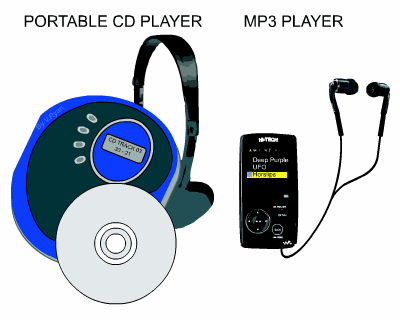| CLICK HERE FOR INDEX PAGE | |
PRODUCT DEVELOPMENT AND THE ENVIRONMENT CD PLAYERS AND MP3 PLAYERS |
|
| V. Ryan © 2011 | |
| PDF FILE - CLICK HERE FOR PRINTABLE WORKSHEET | |
|
Portable CD players were popular in the 1990s. People used them to listen
to music, whilst on the move and when relaxing. However, MP3 players are
used widely today. Personal CD Players are regarded as being less environmentally friendly than MP3 players. How environmentally friendly is a typical CD player, in comparison to a typical MP3 player? |
 |
| PORTABLE CD PLAYER | MP3 PLAYER |
| BATTERIES: | |
| Portable CD Players use batteries that need replacing once they run low. The old batteries are usually thrown away and replaced with new ones. The batteries often end up on rubbish tips. |
MP3 players often have built-in rechargeable batteries. The do not need
replacing and can be recharged thousands of times, before losing their
efficiency. |
| POWER CONSUMPTION: | |
| CD players need higher levels of electrical power to work. They use more energy, because of their mechanical/moving parts and components. | MP3 players are composed of low power components and no moving mechanical parts. Less electrical power is needed for their operation. |
| SIZE: | |
| CD players are physically larger than MP3 players and more materials are used during their manufacture. | MP3 players are small compared to CD players, requiring smaller amounts of materials for their manufacture. |
| RECYCLING: | |
|
Recycling of CD players is complex, due to the number of components and
parts that need disassembling, at the end of their life cycle. CD discs cannot be recycled, due to the type of materials used in their manufacture and the number of layers that form the disc. |
MP3 players are small and have fewer parts / components. They are easier
to disassemble and recycle than CD players. The music tracks are simply deleted, when not required. |
| USEFUL LIFE: | |
| Due to the number of mechanical parts, CD players tend to have a shorter working life, compared to MP3 players. | MP3 players have a longer working life than CD players, because they do not have moving mechanical parts. |
| TRANSPORT AND DISTRIBUTION: | |
| CD Discs require transportation in order to be distributed to shops and retailers. This uses fuel, producing pollution, causing damage to the environment. |
Music tracks for MP3 players can be downloaded in a digital format.
Distribution is electronic, requiring very little energy. |
| CLICK HERE FOR PRODUCT DESIGN INDEX PAGE | |